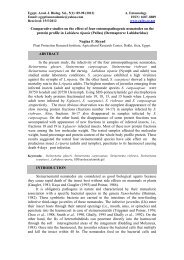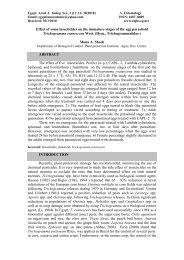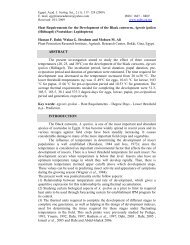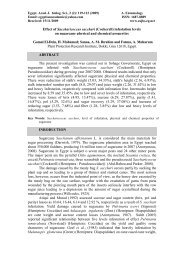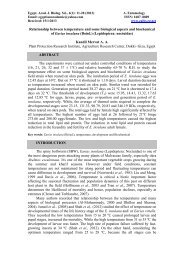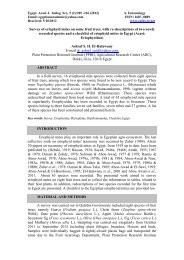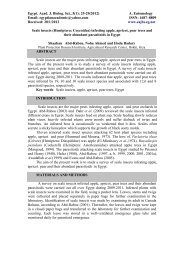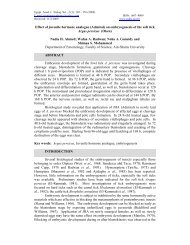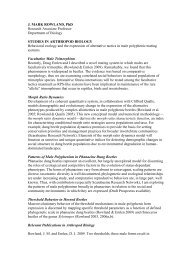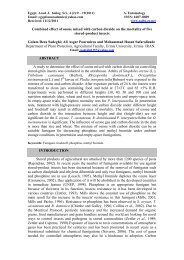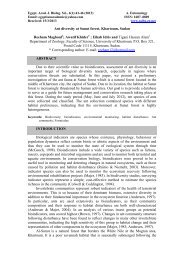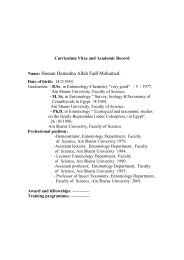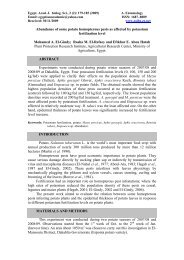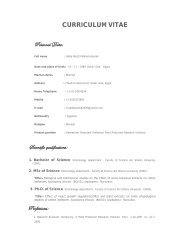Comparison of RAPD and PCR-RFLP markers for classification and ...
Comparison of RAPD and PCR-RFLP markers for classification and ...
Comparison of RAPD and PCR-RFLP markers for classification and ...
Create successful ePaper yourself
Turn your PDF publications into a flip-book with our unique Google optimized e-Paper software.
192<br />
Fatma H. Galal<br />
generated 586 monomorphic b<strong>and</strong> <strong>and</strong> 374 polymorphic b<strong>and</strong>s in a total <strong>of</strong> 960b<strong>and</strong>ed<br />
<strong>RFLP</strong> patterns. A total <strong>of</strong> 900 (<strong>RAPD</strong>), 960 (<strong>RFLP</strong>) <strong>and</strong> 1860 (<strong>RAPD</strong>+<strong>RFLP</strong>)<br />
distinct b<strong>and</strong>s obtained were used <strong>for</strong> cluster analysis. The three UPGMA<br />
dendrograms revealed that 80% similarity cut-<strong>of</strong>f value gave the same two major<br />
clusters. C. maculatus <strong>and</strong> C. bicolor were clustered in the same genotype while the<br />
M. pharoensis was clustered in a separate genotype (Fig. 3). Chi square <strong>and</strong> Fisher's<br />
tests revealed significant differences between both M. pharoensis <strong>and</strong> C. maculatus<br />
<strong>and</strong> between M. pharoensis <strong>and</strong> C. bicolor. However no significant difference<br />
between C. bicolor <strong>and</strong> C. maculatus was observed in cases <strong>of</strong> <strong>RFLP</strong> <strong>and</strong><br />
<strong>RAPD</strong>+<strong>RFLP</strong> data.<br />
DISCUSSION<br />
Compared to st<strong>and</strong>ard <strong>RFLP</strong> analysis, <strong>PCR</strong>-<strong>RFLP</strong> has many advantages.<br />
However, amplification <strong>of</strong> specific regions requires knowledge <strong>of</strong> the flanking<br />
sequences to obtain the primers needed <strong>for</strong> the reaction (Saiki et al. 1988). <strong>RAPD</strong>-<br />
<strong>PCR</strong> technique does not require knowledge <strong>of</strong> specific sequences, but rather uses<br />
r<strong>and</strong>om 10 base-pair primers. This method has become very useful <strong>for</strong> population<br />
genetic <strong>and</strong> taxonomic studies (Williams et al. 1990; Welsh <strong>and</strong> McClell<strong>and</strong>, 1990).<br />
As reported in this study, after a screen <strong>of</strong> 40 r<strong>and</strong>om primers, 18.4, 9.3, 11.3<br />
<strong>and</strong> 33.0% polymorphic DNA <strong>markers</strong> were obtained between M. pharoensis <strong>and</strong> C.<br />
maculates, M. pharoensis <strong>and</strong> C. bicolor, C. maculates <strong>and</strong> C. bicolor <strong>and</strong> between M.<br />
pharoensis, C. maculates <strong>and</strong> C. bicolor, respectively. Comparable levels <strong>of</strong> genetic<br />
polymorphism were obtained using <strong>RFLP</strong> marker system (15.8, 14.8, 5.4 <strong>and</strong> 39.0%<br />
between M. pharoensis <strong>and</strong> C. maculates, M. pharoensis <strong>and</strong> C. bicolor, C. maculates<br />
<strong>and</strong> C. bicolor <strong>and</strong> between M. pharoensis, C. maculates <strong>and</strong> C. bicolor, respectively).<br />
Interestingly, the phylogenetic <strong>and</strong> statistical analyses <strong>of</strong> the data obtained from<br />
<strong>RAPD</strong>, <strong>RFLP</strong> <strong>and</strong> <strong>RAPD</strong>+<strong>RFLP</strong> marker systems resulted in clustering C. maculatus<br />
<strong>and</strong> C. bicolor in one major genotype <strong>and</strong> M. pharoensis in a separate genotype.<br />
These results suggested that C. maculatus <strong>and</strong> C. bicolor have a common ancestor <strong>and</strong><br />
are genetically closer to each other than to M. pharoensis.<br />
These results clarified that the same results (in terms <strong>of</strong> degree <strong>of</strong><br />
polymorphism, precision <strong>of</strong> genetic distance estimates <strong>and</strong> the statistical power <strong>of</strong> the<br />
test) were obtained using either the data <strong>of</strong> <strong>RAPD</strong> or <strong>RFLP</strong> marker systems. El-Alfy<br />
et al. (2009) assessed genetic variation among nile tilapiine fishes by <strong>RAPD</strong> <strong>markers</strong>.<br />
Alam et al. (2006) used <strong>PCR</strong>-<strong>RFLP</strong> successfully to identify four members <strong>of</strong><br />
Anopheles annularis group <strong>of</strong> mosquitoes. Nagaraju et al. (2001) compared four<br />
marker systems (<strong>RFLP</strong>, <strong>RAPD</strong>, ISSR-<strong>PCR</strong> <strong>and</strong> SSRs) in genetic analysis <strong>of</strong> the<br />
silkworm, Bombyx mori. They concluded that ISSR-<strong>PCR</strong> is best suited <strong>for</strong> generation<br />
<strong>of</strong> the volume <strong>of</strong> in<strong>for</strong>mation required <strong>for</strong> per<strong>for</strong>mance <strong>of</strong> such a task. Chapini et al.<br />
(1999) investigated the genetic relationship between four Anagrus hymenopteran<br />
species using <strong>RAPD</strong> <strong>markers</strong> <strong>and</strong> found that they represent four genetically distinct<br />
species. Aljanabi et al. (1998) indicated the potential <strong>of</strong> <strong>RAPD</strong> <strong>markers</strong> to<br />
demonstrate the genetic variability <strong>of</strong> stink bug egg parasitoids. Wilkerson et al.<br />
(1993) reported that <strong>RAPD</strong> analysis will prove to be a powerful <strong>and</strong> technically<br />
accessible tool in elucidating the systematics <strong>of</strong> uncharacterized dipteran species<br />
complexes from natural populations. They also discussed some problematic<br />
characteristics <strong>of</strong> <strong>RAPD</strong> b<strong>and</strong>ing patterns <strong>and</strong> approaches to overcome these problems<br />
were suggested.



